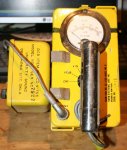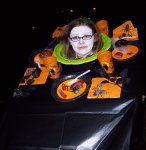x-ray
New member
- 141
- 1
- 0
- Location
- Brockport, NY
Eric,
Drop me a PM if you need something precisely measured for radiation. I have access to some advanced radiation detection equipment.
The question you want to ask yourself is that are concerned with dose or contamination or both. Radiation exposure/dose is sort of like the heat and light from a camp fire whereas the contamination would be hot smoke, embers, etc that can get on your hands. A good meter for contamination (e.g. to check and see if you get speedometer radium dial dust on your hands) isn't the best tool to also measure how much radiation dose you get from the intact gauge at a few inches away from it.
An ion chamber is great for dose rate exposures and a thin-window Geiger is best for contamination.
If you want a simple yes/no meter to detrmine whether something is radioactive or not, the CDV-700 civil defence geiger counters are actually adequate for most circumstances. I think I have a few sitting around - I picked up Thousands from Albany, New York Civil defense in August 2001, After September The federal government contacted me and wanted them to give out to federal agencies - and I gave them to the feds for no charge 9/11 got us all scared of a nuke attack. will check and see if I kept one you can have. Will PM you if I find one.
Drop me a PM if you need something precisely measured for radiation. I have access to some advanced radiation detection equipment.
The question you want to ask yourself is that are concerned with dose or contamination or both. Radiation exposure/dose is sort of like the heat and light from a camp fire whereas the contamination would be hot smoke, embers, etc that can get on your hands. A good meter for contamination (e.g. to check and see if you get speedometer radium dial dust on your hands) isn't the best tool to also measure how much radiation dose you get from the intact gauge at a few inches away from it.
An ion chamber is great for dose rate exposures and a thin-window Geiger is best for contamination.
If you want a simple yes/no meter to detrmine whether something is radioactive or not, the CDV-700 civil defence geiger counters are actually adequate for most circumstances. I think I have a few sitting around - I picked up Thousands from Albany, New York Civil defense in August 2001, After September The federal government contacted me and wanted them to give out to federal agencies - and I gave them to the feds for no charge 9/11 got us all scared of a nuke attack. will check and see if I kept one you can have. Will PM you if I find one.





